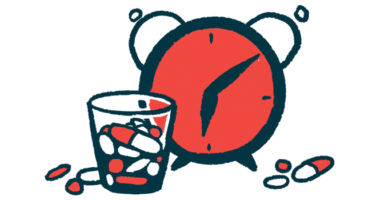Takhzyro Significantly Reduces Rate of Hereditary Angioedema Attacks, Phase 3 Trial Shows

Routine treatment with Shire‘s Takhzyro (lanadelumab) — given as a 300 mg dose every two weeks — significantly reduces the rate of acute attacks in hereditary angioedema (HAE) patients age 12 and older, a Phase 3 trial shows.
The treatment also kept more patients attack-free during the 26-week study, reduced the number of attacks requiring acute treatment, and lowered the number of moderate to severe attacks.
Results from the HELP Phase 3 trial (NCT02586805) were published in the journal JAMA, in the study, “Effect of Lanadelumab Compared With Placebo on Prevention of Hereditary Angioedema Attacks.”
“For those living with this chronic and unpredictable disease, it is important that they can reduce the frequency of their HAE attacks. Additional analysis of the HELP Study continues to support the use of lanadelumab as a preventive subcutaneous treatment option for HAE in appropriate patients 12 years of age and older,” Andreas Busch, PhD, executive vice president, Head of Research and Development at Shire, said in a press release.
Most angioedema attacks are caused by the excessive release of bradykinin, a protein involved in inflammation that increases the permeability of blood vessels, allowing fluid to escape and causing tissue swelling (edema).
Takhzyro is an antibody that blocks the activity of kallikrein, which controls the levels of bradykinin.
HELP was designed to determine whether Takhzyro could be used as a routine treatment to prevent attacks. It was the largest prevention study to date in HAE patients, and its findings have led to Takhzyro’s approval in the U.S. and Canada and to a positive opinion for European approval.
The study recruited 125 patients with type 1 or type 2 HAE, age 12 and older, across 41 sites in Canada, Europe, Jordan, and the United States. Most patients were women (70.4%) and white (90.4%), and nearly all received treatment across the trial’s 26 weeks (90.4%).
Patients in the trial who had been receiving long-term prophylactic therapy were required to undergo a washout period of two or more weeks. Then, before receiving treatment, participants entered a four-week period to determine their baseline attack rate.
Participants were randomly assigned one of three of Takhzyro’s treatment regimens — 150 mg every four weeks, 300 mg every four weeks, or 300 mg every two weeks — or a placebo, given as under-the-skin injections.
The double-blind study showed that Takhzyro significantly reduced the rate of monthly attacks across all three doses. The 300 mg every two weeks dose, however, showed the best results, causing an 87% reduction in the mean number of attacks per month, compared to placebo.
Takhzyro also reduced the number of attacks requiring acute treatment and the rate of moderate to severe attacks, with the 300 mg every two weeks dose showing the greatest reductions.
Over the 26-week period, 44.4% of patients receiving this dose also remained attack-free, compared to 2.4% of patients on placebo. Also, while these patients had a median 27.3 days per month without attacks, those on placebo were attack-free for a median 22.6 days every month.
Compared to baseline, 61.8% of patients receiving the highest dose experienced a 90% or higher reduction in the number of monthly attacks. This difference was seen in only 4.9% of patients receiving placebo.
Takhzyro was also associated with improvements in quality-of-life scores over the 26 weeks. Overall, patients receiving the medicine were 3.2 times more likely to achieve a clinically meaningful difference in total quality-of-life scores.
The most common adverse events were injection site pain, infections in the upper respiratory tract, headache, and rash in the injection site. Most were mild to moderate in severity.
“Among patients with hereditary angioedema type I or II, treatment with subcutaneous lanadelumab for 26 weeks significantly reduced the number of attacks compared with placebo, supporting the use of lanadelumab as a prophylactic therapy for hereditary angioedema,” researchers wrote.
At the end of the 26-week treatment period, patients could enter either an open-label extension study (NCT02741596) — designed to examine the long-term safety and efficacy of Takhzyro — or an eight-week safety follow-up.
To date, 212 patients have been included in the HELP extension study, including 109 HELP participants, and results show that patients continue to experience a reduction in HAE attacks in the long term.
“The data we have seen from the HELP open-label extension are very promising and we look forward to receiving the final results,” said Busch.






